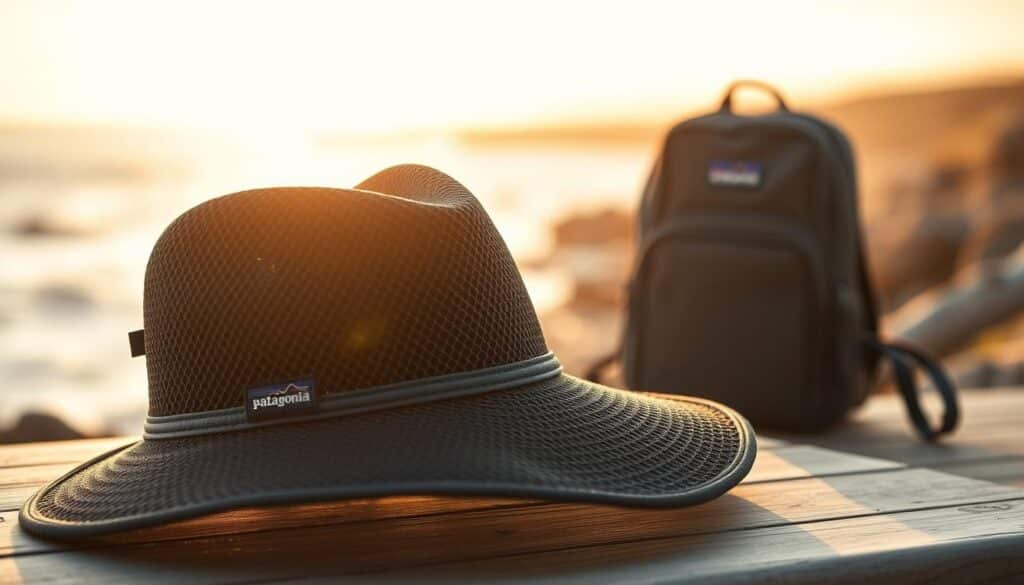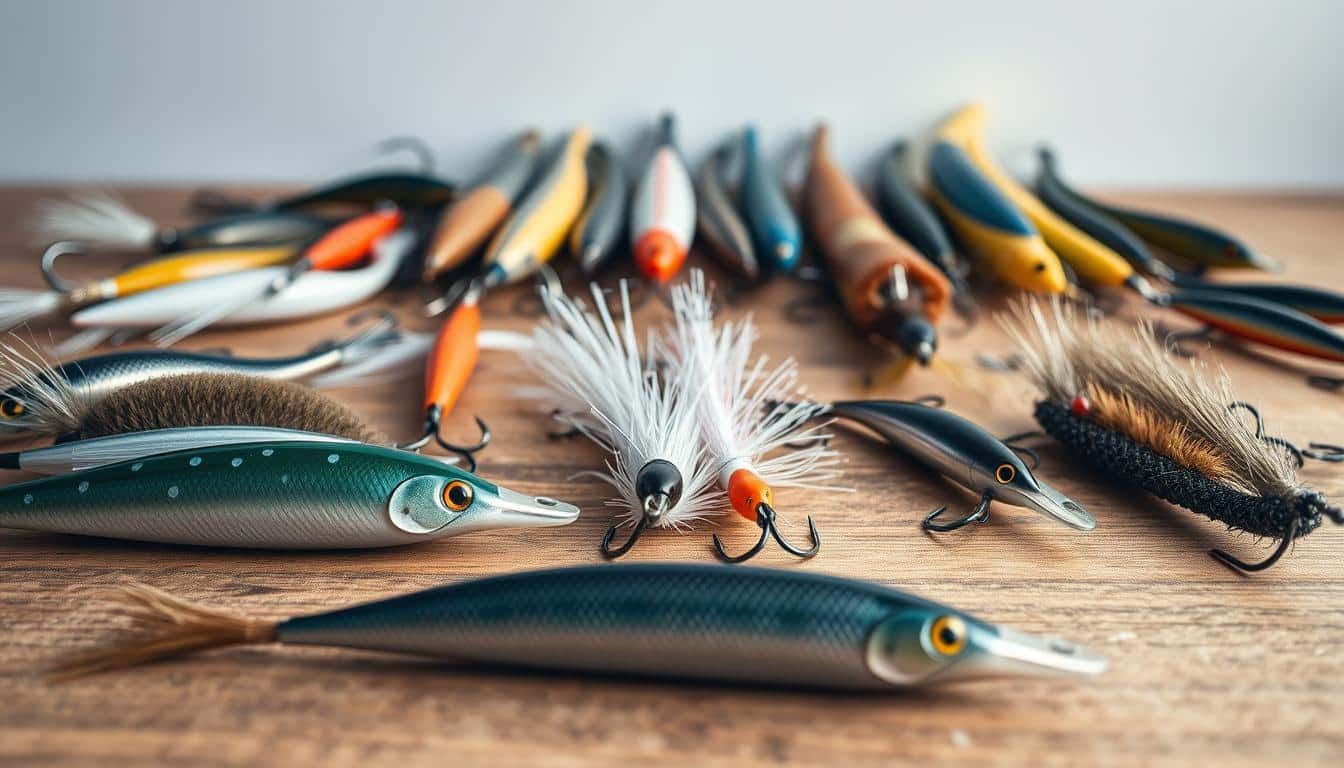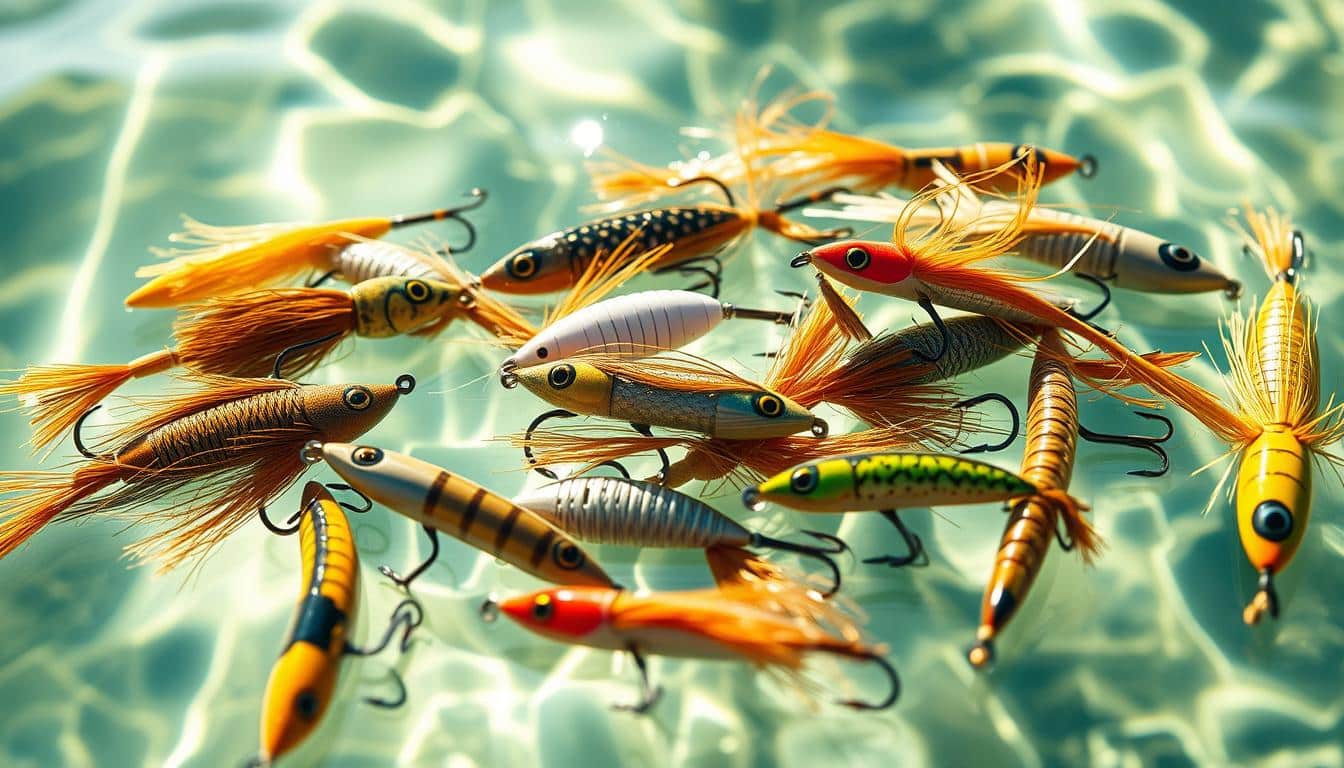This piece showcases leading brands in plastic-free fishing gear and their importance. Brands like Wise Angler, Patagonia, and Adidas are ditching single-use plastics. They’re switching to sustainable options in tackle, packing, and clothes.
Plastic-Free July shows us the impact of single-use plastic on fishing and coastal areas. Grove Collaborative is making big strides with its Beyond Plastic tools. They work with rePurpose Global to cut down and recycle tons of plastic.
Wise Angler is known for its 100% plastic-free gear and bio packaging. Other brands are turning old fishing nets and ocean plastic into wearables. This gives anglers eco-friendly choices for their gear.
This article talks about materials like bamboo and marine-grade metals. These materials are great for both fresh and saltwater fishing. The aim is to focus on brands that care for our oceans and fish well.
Why Plastic-Free Fishing Gear Matters for Oceans and Fisheries
Oceans feel the heavy impact of plastic pollution on life and communities by the sea. Tiny items like packets and synthetic lines drift for years, turning into microplastics eventually. By choosing different materials for gear and tackle boxes, brands, anglers, and retailers can lessen this burden.
Overview of plastic pollution impacts on marine life
Plastic pollution dangers include entangling animals, them eating it, and covering habitats. It means toxins can climb up the food chain when animals ingest plastic pieces. Plus, plastic messes with sand and coral reefs, making it tough for these areas to recover.
How lost and discarded tackle contributes to ocean plastic
Lost fishing gear adds a lot of macroplastic and microplastic pollution to our oceans. Items like hooks and soft plastics catch on reefs, entrap creatures, and break down into small bits. Making gear and packaging from safer materials can stop this from happening.
Benefits of switching to biodegradable and recyclable materials
- Using biodegradable fishing gear decreases pollution over time and lowers the risk of animals ingesting it.
- Recyclable tackle keeps metals and other resources out of dumps and in use.
- Choosing compostable packaging reduces trash in dumps and the risk of it ending up in our oceans from boats or the shore.
Small choices lead to big changes. Opting for biodegradable gear, wanting benefits of recyclable tackle, and backing companies that cut down on lost gear move us toward better supply cycles. This action guards our fisheries, supports sustainable jobs, and decreases the plastic harming our oceans, seen and unseen.
Top Brands Offering Plastic-Free Fishing Gear
Many companies are ditching plastic in fishing gear, including niche tackle makers and outdoor apparel brands. They’re innovating products and helping clean the ocean. This shows their commitment to the environment and ocean recovery efforts.
Wise Angler: 100% plastic-free terminal tackle and compostable packaging
Wise Angler makes terminal tackle from safe metals and uses compostable packaging. They follow strict environmental standards, stopping over 110 pounds of plastic waste with every 10,000 packets. This makes a real difference in reducing plastic pollution.
In New Zealand and Australia, retailers selling Wise Angler products prove that businesses can cut plastic use and still succeed. This helps spread the message and makes a big impact.
Patagonia and Bureo: recycling fishing nets into NetPlus products
Patagonia and Bureo recycle old fishing nets into new materials used in hats and accessories. They’ve cleared over 1.3 million pounds of nets from oceans, supporting a healthier marine environment. Patagonia also promotes reusing gear through its Worn Wear program.
This effort shows how outdoor brands can find new uses for waste and encourage less reliance on new materials. It’s a shift towards better use of resources.
Adidas with Parley: recycled ocean plastic in apparel and outreach
Adidas works with Parley to turn ocean plastic into shoes and clothes. They also run events like Run for the Oceans to boost awareness and bottle recycling. They’ve managed to recycle tons of waste, spotlighting the role of sport in ocean conservation.
This partnership proves that big brands can incorporate recycled materials and engage a broad audience. It’s a step forward in sustainable fashion.
Other notable names adopting plastic-reduction strategies
- Grove Collaborative uses a Beyond Plastic badge and works with rePurpose Global to measure its positive impact.
- Corona hosts events like Plastic Fishing Tournaments and beach cleanups to fight plastic pollution.
- BIC and TerraCycle are testing pens made from recycled ocean plastic, exploring sustainable packaging and reuse.
Diverse brands are working to limit plastic use and support ocean health. From fishing gear to apparel, these efforts show a commitment to cleaner oceans. They prove that every company, big or small, can contribute to a more sustainable future.
Wise Angler — Plastic-Free Tackle Designed for Performance
Wise Angler tackle is made for fishing and helps the planet too. It’s strong enough for both saltwater and freshwater fishing. This brand helps by not using single-use plastics.
Product range: hooks, swivels, and terminal tackle in marine-grade metals
Wise Angler offers important gear: hooks, swivels, and more, all made from strong marine metals. These items won’t rust easily and are made to last. This means you get great gear without harming the environment.
Certified compostable packaging standards (AS 5810, EN 13432, ASTM D6400)
The packaging is eco-friendly, meeting standards like AS 5810 and EN 13432. You can compost boxes and wraps at home or in special facilities. This packaging does not include plastic like bubble wrap.
Real impact metrics and retailer adoption (prevention of plastic per packets sold)
Over 55 stores in New Zealand and Australia are choosing Wise Angler. They want to stock sustainable products. Every 10,000 packets sold prevent more than 50 kilograms of plastic waste.
- Stores display these products to share their support for the environment.
- It’s easy for stores to start selling these eco-friendly fishing supplies.
- Stores can see how their choices help decrease plastic use over time.
Wise Angler shows that you can have strong, reliable fishing gear and help the environment. The brand uses smart packaging and durable metals. This helps reduce plastic waste while offering great products for fishing.
Patagonia and Bureo — Turning Abandoned Nets into Useful Gear
Patagonia teams up with Bureo to transform old fishing nets into long-lasting items. This effort is all about grabbing abandoned nets to remake them. They become valuable materials for making outdoor wear and gear.

NetPlus uses fishing gear that would otherwise litter our shores. Bureo takes these nets, cleans them, and then grinds them into small pellets. Patagonia uses these pellets to make parts for clothes and hats that are tough and last long.
-
NetPlus keeps things valuable and tough by reusing waste.
-
This method fights a big cause of ocean trash by turning old nets into new stuff.
Dealing with ocean plastic needs big efforts. Patagonia and Bureo together have cleared over 600,000 kilograms of nets from the ocean. This shows that reused nets can supply a consistent base for products.
-
Things like the edges of caps and parts for accessories come from NetPlus.
-
Recycling these nets helps stop the stream of garbage contributing to ocean pollution.
Patagonia’s Worn Wear program adds to recycling nets by making products last longer. It focuses on repair, reuse, and resell to lessen the need for new materials. This pairs well with recycling, pushing for a circular approach to outdoor products.
Patagonia’s goal is to get half its synthetic materials from recycled sources by 2025. Using NetPlus and promoting Patagonia Worn Wear creates a strong cycle. It combines recycling with longer use of products to cut down waste.
Adidas and Parley for the Oceans — From Collected Plastic to Performance Gear
Adidas partners with Parley for the Oceans to turn ocean waste into high-quality sportswear. Together, they clean beaches and coasts, then use the plastic for new products. This method not only cleans our oceans but also boosts the demand for recycled materials.
Run for the Oceans is a big campaign that converts running into a fight against pollution. People run, and their efforts help collect tons of ocean plastic. This trash is then recycled, thanks to the support of those who care about our planet.
Through this partnership, Adidas makes shoes and clothes out of recovered ocean plastic. They have created millions of items, including sustainable shoes and sportswear. Items like lightweight shirts, swimwear, and shoe parts are made from this recycled material.
Sporting goods companies can change how we think about the environment. They use famous athletes and big events to promote recycling. When they focus on making products from recycled materials, the whole recycling system improves and grows more valuable.
- Collection: community runs and cleanups supply feedstock for recycled materials.
- Processing: plastic is sorted, cleaned, and turned into yarn and filament.
- Production: yarn becomes sportswear from ocean plastic and recycled ocean plastic shoes.
Events like Run for the Oceans highlight the power of marketing in promoting a sustainable cycle. The Adidas and Parley collaboration turns beach litter into items we can buy. This initiative helps improve recycling processes on a bigger scale.
Brands with Plastic-Neutral and Ocean-Recovery Initiatives
More companies are combining product design with programs to cut down plastic pollution. This includes tracking programs in retail that help avoid plastic use. It also covers beverage companies supporting beach cleanups and brands recycling materials. These efforts show how committed brands turn their promises into real results.

Grove Collaborative leads the way in making an impact through retail. Its Beyond Plastic badge helps customers pick products with less plastic, and connects purchases to the Beyond Plastic Impact Tracker. This tracker shows the amount of plastic avoided and reclaimed for each item sold. Since 2020, Grove has kept millions of pounds of plastic from polluting our planet. They partner with rePurpose Global to save plastic from reaching the oceans.
- Impact tracking that shows avoided plastic per order.
- Product labeling that nudges sustainable purchases.
- Partnerships to scale recovery of ocean-bound material.
Corona takes a unique approach in the drink industry, focusing on recovery and community drives. Corona claims to be net-zero plastic by collecting more waste than it produces, thanks to beach cleanups and creative events. They even pay fishers to gather marine trash in the Plastic Fishing Tournament. This provides income and helps clean the beaches.
- Community beach cleanups and education campaigns.
- Programs that turn waste into value for local collectors.
- Interactive experiences to teach consumers about personal plastic footprints.
BIC and TerraCycle show us a great example of circular products. BIC makes pens from recycled ocean-bound plastic, collected through TerraCycle’s networks. Pilot projects have turned collected waste into new pens and even outdoor furniture. This shows how everyday items can be recycled in a full circle.
- Collection networks that funnel ocean-bound plastic into manufacturing.
- Products made with high shares of recycled feedstock.
- Case studies that demonstrate scalable reuse of recovered materials.
There are three main strategies for brands to combat plastic pollution. First, reduce plastic at the retail level and track the progress. Second, engage the community and recover waste on an industry-wide scale. Third, promote product circularity through takeback programs and remanufacturing. Sharing these achievements helps customers choose better brands and supports larger ocean recovery efforts.
Materials and Components to Look For in Plastic-Free Tackle
When choosing plastic-free tackle, it’s crucial to pick materials that work well in water and degrade safely if lost. Look for key components that are better for building a green fishing kit or products for stores.
-
Bamboo and hardwoods — Bamboo rods are strong, lightweight, and come from a renewable source if properly harvested. Wooden lures and bobbers float naturally and perform in a way that many fishers like. Since they’re biodegradable, they lessen the chance of microplastic pollution if the gear goes missing.
-
Cork and natural-fiber lines — Cork handles are comfy to hold, don’t soak up water, and are sustainable. Lines made from hemp or other natural fibers like jute or cotton are biodegradable. They’re good alternatives to traditional lines, but check their strength and resistance to wear, especially for saltwater fishing.
-
Marine-grade metals — Opt for stainless steel and other alloys that resist corrosion for hooks and weights. These metals work as well as regular tackle but don’t rust and can be recycled, making them a smarter choice that uses less plastic.
-
Packaging and fulfillment — Look for compostable packaging certified by standards like AS 5810, EN 13432, or ASTM D6400. This type of packaging reduces waste in landfills and shows that a brand is serious about cutting down on single-use plastics.
Remember, natural materials may not last as long or work as well in saltwater. Always check the product details, testing reports, and guarantees. Stores should have samples and offer advice so fishers can find the right bamboo rods or wooden lures for their fishing needs.
When marketing products, make sure to mention cork grips, hemp lines, metal hooks, and compostable packaging. Clear info on these helps customers make smart choices. It also builds trust and encourages the shift to eco-friendly fishing gear.
How to Choose and Stock Plastic-Free Fishing Gear for Anglers and Retailers
Finding the right plastic-free tackle starts by focusing on the angler’s needs. It’s important to match gear with their fishing styles. This ensures they get the best performance and value. Sharing detailed specs and the benefits of choosing plastic-free options can sway buyers.
Match gear to fishing style
Saltwater anglers require gear that can withstand corrosion and offer strength. Look for marine-grade metals and natural fibers designed for the sea. For freshwater fishing, materials like bamboo, cork, or hemp work well. They offer a gentler touch and are eco-friendly. Always label items clearly to help anglers choose correctly between freshwater and saltwater gear.
Durability, performance, and cost
Plastic-free gear can be just as good, or better, than traditional gear if it’s well-made. Check how they measure up in strength and durability tests. Highlight warranty and success stories from brands to build confidence. Although the initial cost may be higher, the long-term savings from durability can make them a smarter buy.
Retail tips for merchandising and sales
Switch to compostable packaging for shelves and highlight eco-friendly aspects. Certifications for compostability can help gain customers’ trust. Train your staff to share information about the environmental benefits of these products. This can turn customer interest into sales.
- Technical checklist: material (bamboo, cork, hemp), finish (marine-grade), tensile and corrosion ratings, warranty.
- Cost framing: show per-use cost and lifespan vs single-use plastics.
- In-store actions: repair clinics, drop-off collections, and demo days that highlight product performance.
Make it easy for retailers to order and restock with wholesale onboarding. Provide essential tools like shelf tags and certifications for compostability. This helps stores recommend plastic-free options to customers more effectively.
Telling a story can increase sales. Share how adopting these products impacts the environment positively. By combining data with proof, you can motivate buyers to make sustainable choices.
Conclusion
The success story of sustainable fishing is real. Brands like Wise Angler and Patagonia lead by example. They use plastic-free gear, proving it’s possible and effective. Their efforts include using compostable packaging and recycling nets. They’ve kept millions of pounds of waste from oceans with their programs.
To fish responsibly, choose gear made of materials like bamboo and cork. Look for products with certifications such as AS 5810 and ASTM D6400. These mean the products are eco-friendly. Retailers who provide these options and show their positive impact encourage more people to fish sustainably.
For a lasting change, we need better recycling systems and more demand for recycled products. Supporting transparent brands helps. They turn waste into useful items and prevent more plastic from harming the ocean. Making eco-friendly choices in fishing gear sets a new standard for protecting our seas.
FAQ
What is plastic-free fishing gear and why does it matter?
Which brands are leading the shift to plastic-free tackle and ocean plastics recovery?
What measurable outcomes do these brands report?
Are plastic-free tackle products durable and suitable for saltwater use?
What certifications should retailers and anglers look for on packaging?
How does Wise Angler’s approach differ from traditional tackle packaging?
What is NetPlus® and how does recycling abandoned fishing nets help?
Can switching to plastic-free gear influence customer behavior and retailer sales?
What tradeoffs should anglers expect when choosing natural-fiber lines or wooden components?
How can retailers stock plastic-free gear effectively?
Do plastic-reduction programs like Grove’s Beyond Plastic badge and rePurpose partnerships actually recover ocean-bound plastic?
How do large campaigns like Adidas-Parley’s Run for the Oceans scale collection and recycling?
Will plastic-free gear cost more, and is it worth the price?
What immediate steps can U.S. anglers take to reduce tackle-related plastic pollution?
Content created with the help of Artificial Intelligence.



